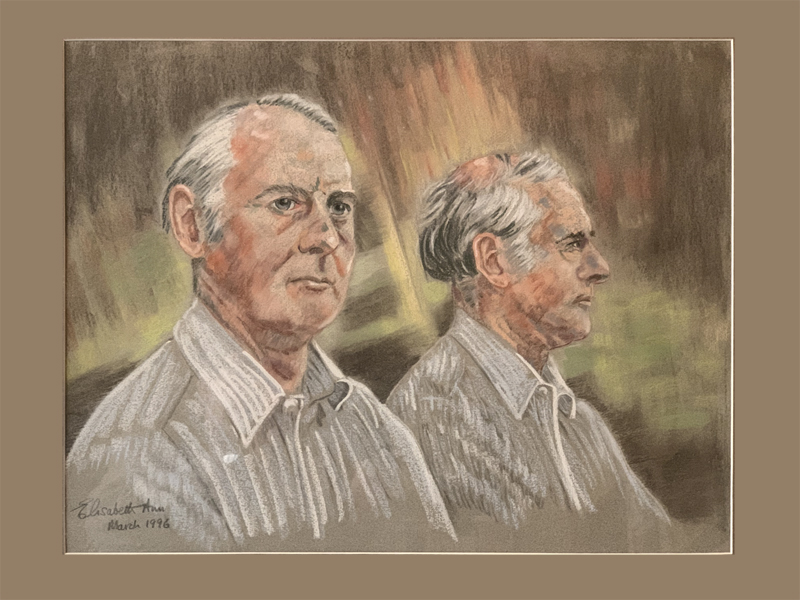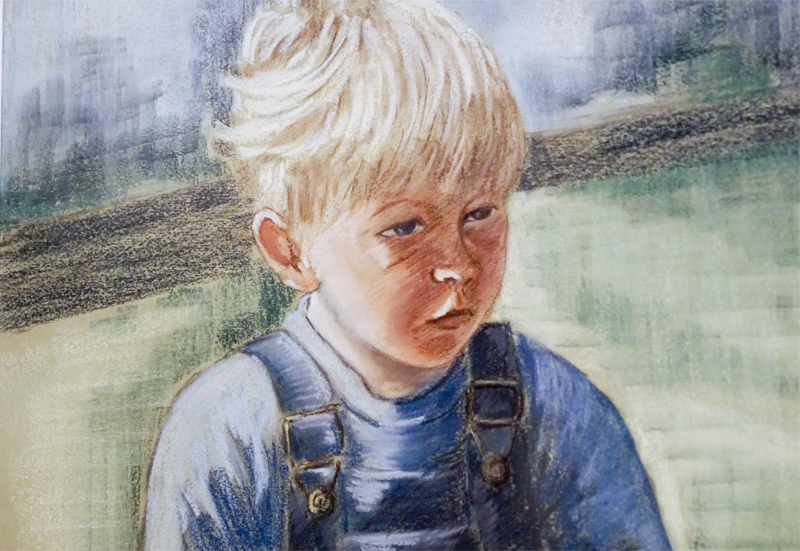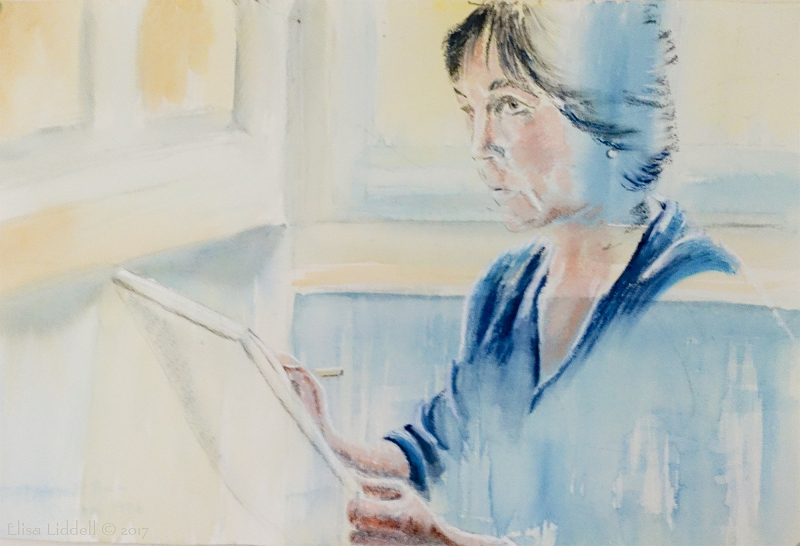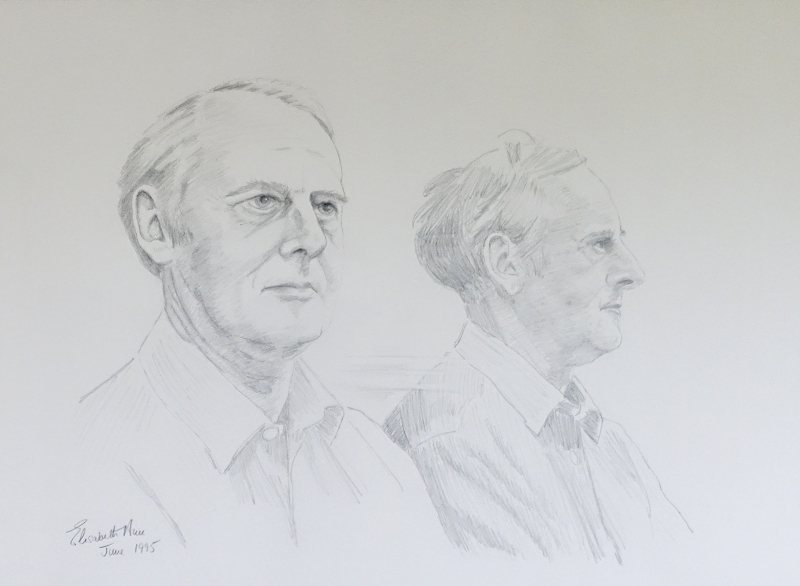
After working in pencil, then charcoal and Conte crayon the next logical step was to expand the range of colours … and that meant discovering pastels! In all my school years of art lessons I had never been introduced to pastels, and it was such a revelation! Love at first sight .. well touch!
In practical terms for me it was still a dry medium, and easier to use while confined to bed, though in fact I did need to work somewhere where I could create a dusty environment. I bought my first box of pastels and I was in colour heaven! I painted everything I could get my hands on – everyday things around me.

What is unique about pastel painting?
With pencil, oils and watercolours you start with a white canvas – and either prime the canvas with a background colour, or work from light to dark colours and tones. But with pastel the ideal way is to use a paper with a mid tone, and work towards the lightest and darkest tones using the mid-tone ground as an integral part of the image.
Pastel paper is thicker than that used in drawing/sketching – and most crucially it has a rougher surface, so the dry pigments can stick and hold to the surface.
And the most difficult thing for many painters is that you can’t mix colours. You need a large range of colours in your pastel box. Mixing colours on the paper usually leads to a muddy result – and pastel painting is all about bright, delightful colours!
Learning from Degas
Yes, I soon went looking for a ‘teacher’ whose work I could study and learn from. And Degas was/is an undoubted master of the art of pastel painting. He was also a consummate draughtsman, and drew possibly more than he painted. I rarely like the ‘male gaze’ in art past or present. Feminism taught me a lot that explained my dislike, as it critically dissected the ‘male gaze’. So I was surprised that I enjoyed the Degas female nudes I saw. He managed to draw and paint in a more detached way, with figures looking away from the viewer – and I found myself copying some of his bedroom bathing and toilette studies.

Working from mid-toned papers towards both the light and the dark I found I needed to study the tonal range very carefully. The best way to do that is to see the subject in black-and-white. Today we mainly use a digital photograph, I guess – but back then in pre-digital days, I found a piece of glass and painted the back side black, then I could see the image reflected in the glass. It still works well and probably a whole lot quicker for quick reference!
I was still very limited in both energy and mobility, so I used the resources I had to hand. I took photos (often Polaroids) of freeze frames on the TV. I had a video recorder, so I could freeze the tape replay. The quality wasn’t very good, but it gave me a place to start! I was still mainly drawing portraits – heads and shoulders – so painting them seemed like a good way to go. I recorded programmes about painters, so quite a few of my efforts were of painters!

I found it exciting to take different angles and put them together – and really delighted in the way I could show the individual pastel stick marks.

I worked from photos, and experimented with cropping, and also simplifying the backgrounds, as well as trying to catch an outdoor sense of sunshine and shadows.
But I wanted more … could I combine images in such a way that I could both mix the media I was using, and also get a multi-layered effect?

So I began to explore watercolour painting for the first time … to provide a textured paint surface on which to overlay pastel. I needed to use rough watercolour paper, to give some ‘tooth’ for the pastel to cling to. But I was getting excited with my experiments!
I started collecting watercolour paints and papers, and some books on the medium too. And then – as so often happens – LIFE intervened. More accurately ME/CFS intervened, and once again I suffered a severe relapse that lasted for a couple of years.
As I began to recover I decided to change direction completely. Mike was getting excited with the ways computing were opening up possibilities in teaching, and in his own writing and lesson design. And I was becoming aware of the possibilities that the internet and email could offer me. Artistic pursuits while completely isolated and bedbound were very, very lonely! Maybe I could learn computing skills enough to connect with the outside world again? Energy was so limited I had to choose … and decided to learn about computers and how to make them work, and to work for me!
The decision I made then led me into a whole new world. It was the late 1990s by now, and I began to learn basic computing skills. I discovered that there were small ‘palmtop’ computers that could allow me to write while lying down.
As a complete ‘newbie’ I decided to create a website about my new palmtop computers, the Psion 3 and then the Geofox (which was a little bigger and easier for me to use).

Flying by the seat of my pants I designed a website called FoxPop. And it became a really huge website, with an international ‘Editorial Board’ and took me on an amazing journey!
As part of running the site I developed a lot of graphics skills … some referred back to another life where I lectured Journalism students in the print media – some were new departures, into the realm of Photoshop, and digital cameras.
FoxPop ran for 5 years, and those years gave me so much. They brought me into the modern world of computers and early smartphones – and they gave me friends I still have today! But after 5 years, and with the Mike’s ever growing help and participation, it became too much for us to continue. So reluctantly we closed the site.
And so the next part of my creative adventure began to emerge and develop. As I began to gain some more energy and stamina, we began to explore the area we lived in. And there is plenty of beautiful scenery to explore – landscapes, seascapes and castles, gardens and woodland walks. And so began many years of photography! All manner of cameras and lenses have become part of my creative life – elements of which are covered here.
And so I finally I have come full circle, and am returning from the digital world to the ‘real world’ experience! But now I am starting from a very different place than all those years ago. My visual world has been informed by my photographic journeys. From infra-red cameras, to macro lenses, to Lensbaby optics, to post-processing in Photoshop – all my accumualted knowledge has helped me to define how I want to use actual paint and paper to continue widening my creative interaction with the world around me, as well as my inner world!
On to Watercolours
Back to the Hands On cover page
Flickr holds Elisa’s online Photo Gallery
© 2021 Elisa Liddell





